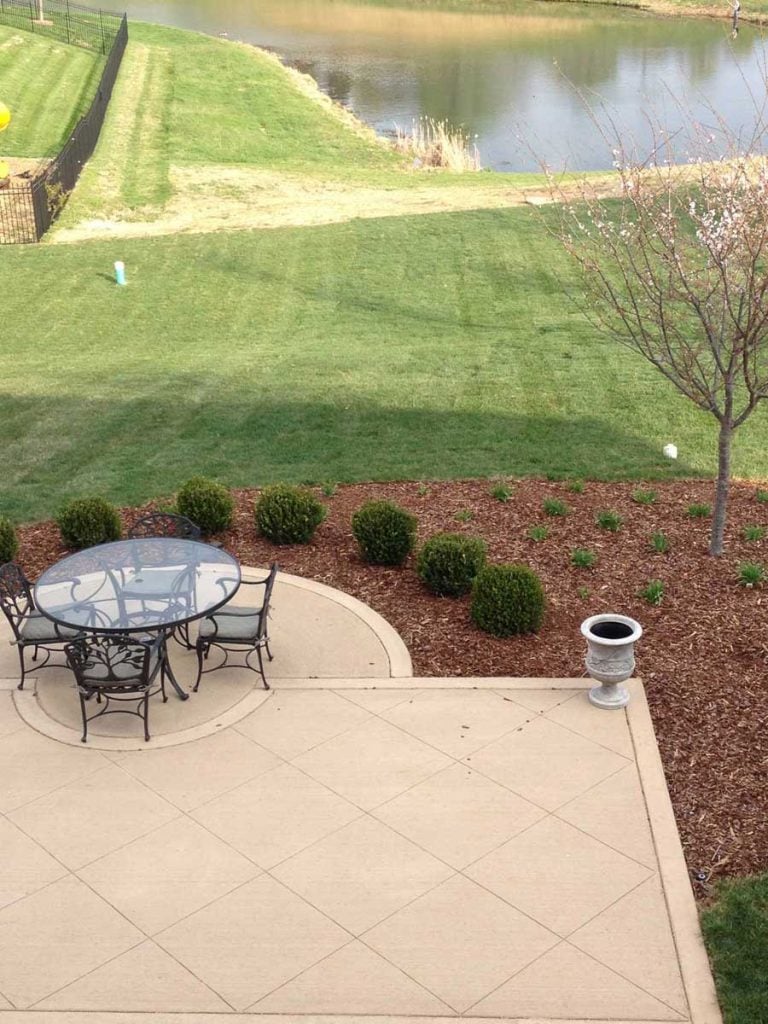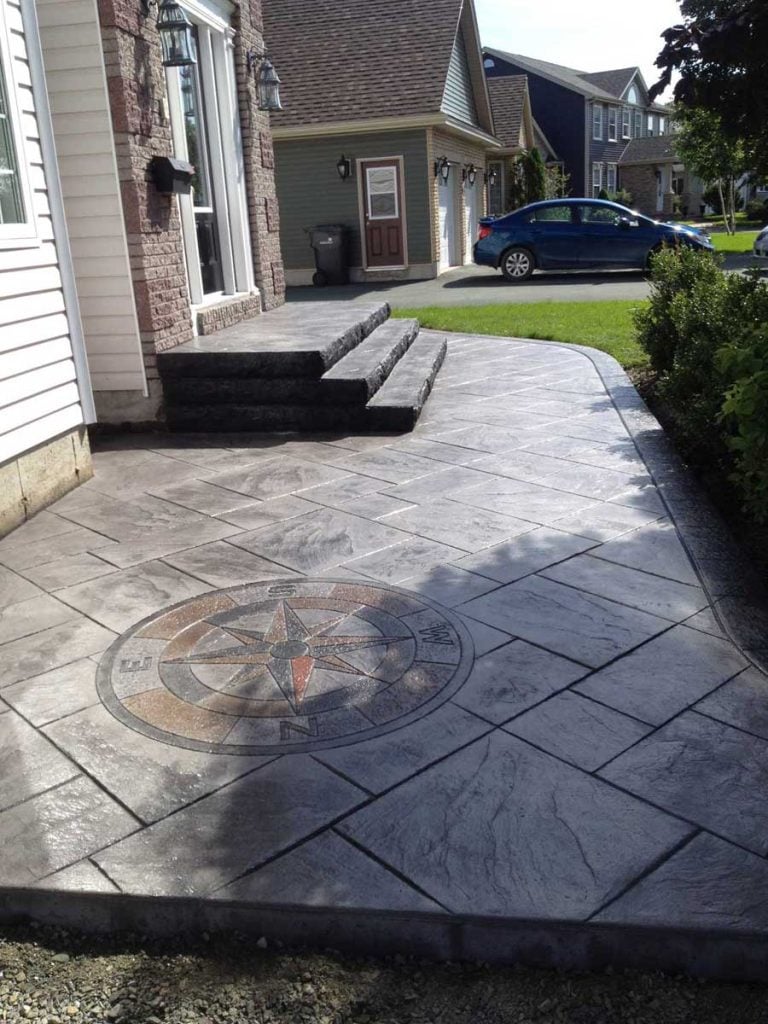Concrete Finishes for Patios
There are many concrete finishes for patios on the market today. Each one comes with its own unique appearance. Concrete finishes for patios also have their own list of utility pros and cons. Choosing the right finish for your patio or your customer’s patio is vital. You must consider appearance and functional demands of the space.

Textured Concrete
Stamped concrete is the classic among decorative concrete finishes for patios. For decades, stamped concrete (also called textured concrete) has been incredibly popular for outdoor patios, pool decks, and sidewalks. Concrete is imprinted using special urethane tools. This creates realistic textures based on common paving materials like brick, stone, and slate.
Stamped concrete is popular because it can replicate other traditional pavement options at a more economical price point. Stamped concrete patios are also easier to maintain than pavers and wood decks. This allows homeowners more time to enjoy their outdoor spaces without worrying about upkeep or replacement. Stamped concrete also offers a near infinite number of texture and color combinations for easy customization.
Unfortunately, stamped concrete does have limitations. It can be slippery when wet. Stamped concrete can also be difficult to shovel in climates where it snows. Some people also complain that it looks artificial. This is especially the case when stamp patterns repeat in an obvious way. This can be avoided by using more thoughtfully designed tools or by randomizing and rotating tools as much as possible.

Slip Resistant Finishes
Various slip resistant finishes care getting more popular. Among the concrete finishes for patios, non-skid finishes are the most utilitarian. There are three main kinds of slip resistant finishes on the market today: salt finish concrete, exposed aggregate concrete, and broom finish concrete. Each of these creates a surface with more traction that is still visually attractive. A slip resistant finish is more useful around pool decks or in regions that experience heavy rains or snow and ice.
Exposed aggregate finishes are usually made using some kind of chemical retarder. After troweling the concrete, the retarder is sprayed on and allowed to sit. Sugar-based retarders must be perfectly timed to get the right finish while modern retarders are far more controlled. Using modern retarders like Surface Deactivator, you can get finishes that barely expose the finest sands to finishes that will expose larger aggregate. All of these will create slip resistant finishes but lighter exposures are more comfortable to walk on.
Rock salt finishes are a retro look common in regions like Southern California. To achieve this design, rock salt is broadcast onto the surface after troweling. The salt is embedded and the concrete is allowed to cure. Afterward, the salt is power washed away. This leaves random pock marks in the surface of the concrete. The natural-looking appearance has been very popular at times and is a good way to create mild texture. Unfortunately, this finish isn’t suitable for freeze thaw climates.
Broom finished concrete is easily one of the most common finishes. It can be found on virtually any sidewalk, driveway, or parking lot. Despite these pedestrian applications, broom finishes can also be made decorative. Artistic finishers can use brooms to create scalloped and fan patterns. They can also make circles and roundels. These finishes are more labor than traditional broom finishes, but they are still supremely functional and economical.
Smooth Finishes
Smooth finishes are created by troweling the concrete and leaving it. Of the concrete finishes for patios, this is the simplest and most cost effective option. In most cases, a smooth finish will actually have a very slight texture that will lend some slip resistance. Hard troweled finishes – those created by steel trowels or power trowels – should generally be avoided on exterior concrete. While these finishes are cost effective and durable, they don’t tend to add much visual appeal. This can be improved upon by using colored concrete or concrete stains.
Concrete Patio Colors
Choosing the right color for your concrete patio is very important. In general, there are four methods for coloring concrete patios: Integral colors, color hardeners, stains, and recoloring products.
Integral colors are pigments mixed into the concrete before it is poured. This is the most durable form of color because it will not fade or wash out. More importantly, it cannot chip or flake off because the color is throughout the concrete. This also means the sides of the concrete slab will be colored just the same as the finished surface. This is important for steps and above-grade concrete. However, integral colors are more limited in color selection. The other ingredients in the concrete will also affect the color, meaning the color range is generally limited to various shades of red, gray, black, brown, yellow, and tan. More vibrant colors are available, but they require much more costly materials. Using multiple colors will require multiple pours.
Color hardeners are finished onto fresh concrete. They create a dense surface that is richly and vibrantly colored. Because they are only coloring the surface, less materials is required and they can more consistently produce a wider range of colors. However, color hardeners will require more labor to use. They do not color the sides of a slab or vertical surfaces, either. If the surface of the concrete is chipped or damaged, the color may be removed. Color hardeners are good for when multiple colors are used on the same project.
Stains are applied to the concrete after it has cured. Acid stains chemically and permanently change the color of the concrete. Water based stains impregnate the pores of the concrete with pigment, much like water colors. In both cases, the top layers of the concrete end up with a translucent color that is great for accents and designs. Stains can be used as a primary color, but their translucent nature means they can’t always create the bold, consistent coloration that is desired. However, they are good for creating natural and mottled color.
Recoloring products are a broad category of materials designed to color existing concrete. Recoloring products can be used to restore or enhance existing concrete. Almost across the board, recoloring products are surface applied. One such recoloring product is Brickform Cem-Coat. This is a cementious coloring product that is applied much like paint. it creates a durable, opaque colored surface that looks and feels like concrete.

Sealing Concrete Patios
Decorative concrete and colored concrete should always be sealed. This protects the concrete from staining and soiling. It also enhances color and creates a more attractive surface overall. Sealers can also be used as coloring agents. Products such as Brickform Tinta’ Seal and Brickform Refresh add color while protecting concrete. Additives can be used with some sealers to reduce gloss and enhance traction.
See More

